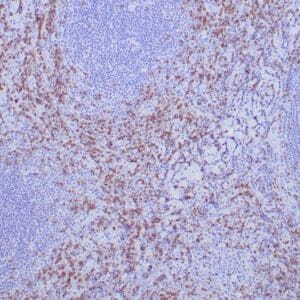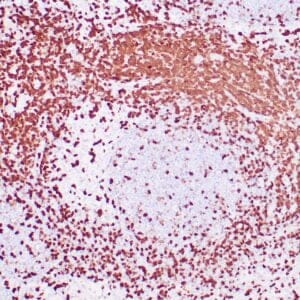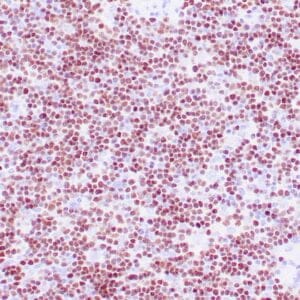| Weight | 1 lbs |
|---|---|
| Dimensions | 9 × 5 × 2 in |
| host | mouse |
| isotype | IgG2b |
| clonality | monoclonal |
| concentration | concentrate, predilute |
| applications | IHC |
| reactivity | human |
| available size | 0.1 mL, 0.5 mL, 1 mL concentrated, 7 mL prediluted |
mouse anti-Lysozyme monoclonal antibody (ZM120) 6244
Price range: $160.00 through $528.00
Antibody summary
- Mouse monoclonal to Lysozyme
- Suitable for: Immunohistochemistry (formalin-fixed, paraffin-embedded tissues)
- Reacts with: Human
- Isotype:IgG2b
- Control: Myeloid leukemia
- Visualization: Cytoplasmic
- 0.1, 0.5, 1.0 mL concentrated, 7 mL prediluted
mouse anti-Lysozyme monoclonal antibody ZM120 6244
| target relevance |
|---|
| Protein names Lysozyme C (EC 3.2.1.17) (1,4-beta-N-acetylmuramidase C) |
| Gene names LYZ,LYZ LZM |
| Protein family Glycosyl hydrolase 22 family |
| Mass 16537Da |
| Function FUNCTION: Lysozymes have primarily a bacteriolytic function; those in tissues and body fluids are associated with the monocyte-macrophage system and enhance the activity of immunoagents. |
| Catalytic activity CATALYTIC ACTIVITY: Reaction=Hydrolysis of (1->4)-beta-linkages between N-acetylmuramic acid and N-acetyl-D-glucosamine residues in a peptidoglycan and between N-acetyl-D-glucosamine residues in chitodextrins.; EC=3.2.1.17; |
| Subellular location SUBCELLULAR LOCATION: Secreted. |
| Structure SUBUNIT: Monomer. |
| Involvement in disease DISEASE: Amyloidosis, hereditary systemic 5 (AMYLD5) [MIM:620658]: A form of hereditary systemic amyloidosis, a disorder characterized by amyloid deposition in multiple tissues resulting in a wide clinical spectrum. AMYLD5 primarily affects the viscera, and the predominant clinical features are renal dysfunction of varying severity, and intra-abdominal bleeding. Inheritance is autosomal dominant. {ECO:0000269|PubMed:8464497}. Note=The disease is caused by variants affecting the gene represented in this entry. |
| Target Relevance information above includes information from UniProt accession: P61626 |
| The UniProt Consortium |
Data
 |
| Human lymph node stained with anti-Lysozyme antibody using peroxidase-conjugate and DAB chromogen. Note the cytoplasmic staining of perifollicular neutrophils and histiocytes.. |
Publications
| pmid | title | authors | citation |
|---|---|---|---|
| We haven't added any publications to our database yet. | |||
Protocols
| relevant to this product |
|---|
| IHC |
Documents
| # | SDS | Certificate | |
|---|---|---|---|
| Please enter your product and batch number here to retrieve product datasheet, SDS, and QC information. | |||
Only logged in customers who have purchased this product may leave a review.















Reviews
There are no reviews yet.